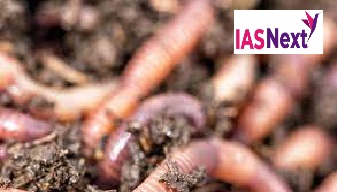CURRENT AFFAIRS
Get the most updated and recent current affair content on Padhaikaro.com
Worms thriving in brains
- IAS NEXT, Lucknow
- 13, Dec 2021

Reference News:-
Workers from Assam have been afflicted with neurocysticercosis (NCC), a preventable disease that wreaks havoc among Assam’s pig-rearing communities among others.
- A study published in the Nature journal earlier this year reported higher prevalence (42.2 per cent) of NCC among patients with active epilepsy in the tea gardens of Assam.
- The findings were in line with older research that NCC was one of the leading cause of seizures in developing countries, particularly in areas without proper sanitation, where pig-rearing was widespread.
How the disease spreads
The life cycle of a pork tapeworm (taenia solium) takes it from pigs to humans and vice-versa.
- Tapeworm eggs are spread through food, water, or surfaces contaminated with faeces. Humans swallow the eggs when they eat contaminated food or put contaminated fingers in their mouth.
- When people consume infected, undercooked pork, they are infected with taenia metacestodes (the larval stage of tapeworm) that develop into adult tapeworm in their intestines (taeniasis).
- The eggs of the tapeworm invade the muscles of the human body to make cysts.
- Sometimes these cysts get into people’s brains, triggering epileptic seizures, headaches, difficulty with balance and excess fluid around the brain
- Adult tapeworms produce eggs that are released in the person’s stool. During open defecation, the eggs can get lodged in nails and end up in humans. Those hands can contaminate food that others eat. A person who has never eaten pork in his life can get infected this way.
- Humans are the only definitive host for the parasite to complete its life cycle. This spillover from pigs to humans and vice-versa makes NCC a zoonotic disease.
- However most recent cases of NCC have been from urban areas in Assam where people eat raw salads
Connection between Assam workers and neurocysticercosis (NCC)
- Assam is the world’s largest tea growing region, with over 800 estates producing half of India’s tea. An estimated 1 million plantation workers pick tea on these estates for Rs 205 a day.
- A 2019 study by non-profit Oxfam revealed that Assam’s tea workers are one of the state’s most marginalised with unsafe working conditions. They lack basic amenities earn low incomes, at high risk of human rights violations.
- To supplement their meager income, many plantation workers — both permanent and temporary — rear pigs. It requires little investment and labor.
- Pork is a staple protein in North East India. It accounts for about 68.75 per cent of pork consumed in India. Nagaland tops the list, followed by Assam and Meghalaya.
- In Assam, pigs are mostly reared in dirty backyards and fed waste. Only 1-2 per cent farmers are keen on hygiene. Commercial pig farmers buy pig feed from and follow a de-worming schedule, he claimed.
- Families of those suffering from NCC have a history of backyard pig farming and open-defecation (due to the lack of proper toilets). Chances of contracting this little-known zoonotic disease are higher in such conditions.
A. Reporting seizures cost jobs
- Many tea garden workers in the region reported losing their jobs due to recurrent epileptic fits.
- In case of such emergencies, tea workers are eligible to seek advances (deductible from future wages).
- The workers want to keep a lid on the real numbers for fear of reprisal.
- Many villagers in this region said they prefer traditional herbal medicines over prescribed synthetic drugs as they are more affordable and within their reach.
B. Extent of medical treatment
- Treatment for NCC can be costly, given the Rs 205 a day wage of a tea worker. The minimum requirement to detect the disease during the onset of an epileptic fit is a CT scan, which costs Rs 1,000 even at government hospitals. A contrast show, to highlight the areas of the body examined, for another Rs 1,500-Rs 2,000 is also needed.
- CT scans are free for those below the poverty line, which should ideally cover tea workers. But the penetration of health welfare schemes such as Pradhan Mantri Jan Arogya Yojana and Atal Amrit Abhiyan is low among them. Producing proofs of income becomes a hassle too. So they end up bearing exorbitant costs.
- The patients should be given medicines such as anthelmintics, antiepileptics, steroids while surgeries should also be available. But a more holistic, One Health approach was needed. The One Health approach addresses human health in conjunction with animal health and surrounding environment. As part of it, public health practitioners would need to prevent tapeworms from getting into human brains in the first place, by employing cost-effective and simple tools for detection of carriers of taenia solium — such as stool examination for humans and checking for shaky tongues in pigs in the rearing areas. Improving pig-farming practices, like using de-worming medicines, can go a long way. But perhaps the most important is to improve sanitation practices and health education through on-ground interventions with communities at risk.
- Very few of those afflicted with NCC in the region have functional toilets at their houses.